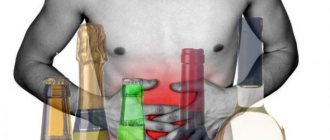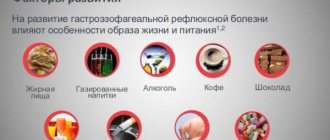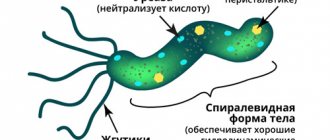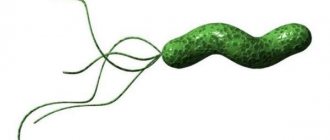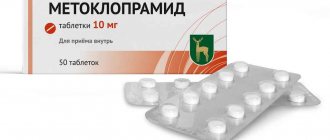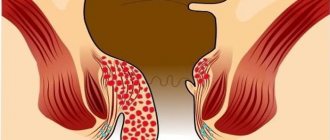Principles of treatment of reflux esophagitis
The basic principles of treatment of reflux esophagitis are:
- introducing dietary restrictions and maintaining a certain lifestyle;
- reducing the acidity of the stomach contents by prescribing appropriate medications;
- stimulation of motility of the digestive tract organs, increased evacuation activity;
- prescribing medications that provide restoration and protection of the gastric mucosa.
It should be noted that all treatment principles are closely interrelated. Failure to comply with one of them significantly reduces the effectiveness of therapy.
Classification, symptoms, diagnosis and treatment of erosive esophagitis
Erosive esophagitis is a pathoanatomical form that is much more common in clinical practice than other forms of this disease.
Its clinical picture is similar to the symptoms of catarrhal esophagitis, but at the same time, patients are much more likely to experience vomiting, belching with blood and pain. To better distinguish between these forms of the disease, we recommend that you become familiar with the symptoms of catarrhal esophagitis by reading the article: Causes, symptoms and treatment of catarrhal esophagitis.
Sometimes the pathological process is complicated by suppuration, bleeding, mediastinitis and perforation.
Fortunately, after the underlying disease is cured, erosive esophagitis goes away without a trace.
Causes of erosive esophagitis
As a rule, the disease develops due to acute or chronic inflammation of the esophagus.
Often, erosions on the mucous membrane occur after burns from technical liquids, alkalis or acids. However, such a disease can result from severe bacterial, viral or fungal infections, and it can also develop in patients taking glucocorticoids and non-steroidal anti-inflammatory drugs for a long time.
Causes of development of erosive reflux esophagitis
Erosive reflux esophagitis is an inflammatory process that develops in the distal part of the esophagus due to reflux of acidic stomach contents. The cause of this condition is gastroesophageal reflux disease, which occurs due to insufficiency of the obturator mechanism of the cardia.
As a rule, the pathological process occurs after the formation of sliding hernias of the diaphragm (its esophageal opening), and it can also develop with severe vomiting, ulcerative stenosis of the gastric outlet and with a short esophagus.
Basic course of treatment
The duration of the main course of therapy for reflux esophagitis is 4 weeks. If an erosive form of the disease is observed, the duration of treatment is increased to 8 weeks, and the dosage of medications may be increased. If changes are present outside the esophagus (especially in older patients), then therapeutic treatment can last up to 12 weeks. When the effect is achieved, the patient is prescribed maintenance therapy.
It should be noted that in many patients with reflux the disease is chronic and accompanied by relapses. In this case, if symptoms of esophagitis are not observed, then medications are prescribed as needed.
At the erosive stage
In the presence of minor and single erosions, treatment of reflux esophagitis can also last 4 weeks. Otherwise, the duration of treatment is 2 months. Proton pump inhibitors are prescribed (morning and evening). Additionally, omeprazole, lansoprazole, pantoprazole, and esomeprazole are indicated. These drugs are also taken twice a day. The most effective in this case is rabeprozole, which is sufficient to take once a day.
Even after successful treatment of erosive reflux esophagitis, the vast majority of patients remain at risk of relapse throughout the year. Such people require long-term therapy with PPI drugs taken in half doses. The treatment regimen is selected by the doctor, taking into account many individual parameters (age, complications, etc.).
At non-erosive stage
If there are no erosions, then PPI is taken once a day for 4 weeks. The amount of the drug taken depends on the intensity of inflammation and is in the range of 10 – 40 mg. After the main course, maintenance therapy is required, the duration of which is determined by the attending physician and can last up to six months.
Symptoms of erosive esophagitis
The main manifestation of the disease is pain that spreads throughout the esophagus. Most often, this symptom occurs after eating.
In addition, there is a burning sensation behind the sternum, sour belching, regurgitation of food, and vomiting with blood.
The general condition of the body also worsens - the temperature rises, general weakness develops, and appetite decreases.
Anemia that occurs against the background of chronic bleeding manifests itself in the form of pale skin and dizziness.
Infection of erosions leads to the development of life-threatening complications - mediastinitis, phlegmon, perforation of the walls of the esophagus with massive bleeding.
The most severe consequence of erosive inflammation is hemorrhagic esophagitis, in which large vessels are damaged.
Barrett's esophagus develops against the background of a long-term inflammatory process.
Possible treatment regimens
In the treatment of reflux esophagitis, the following regimens can be used.
- The same drug is used. Accompanying symptoms, complications and changes in the mucous membrane are not taken into account. This is an ineffective approach.
- Involves diet therapy and antacids. Medicines are prescribed to varying degrees of effect, depending on the severity of the inflammatory process.
- Effective in treating severe forms of the disease. First, use of strong PPIs is indicated. After the inflammatory process is relieved, weak prokinetics are prescribed.
The choice of regimen is made by the attending physician based on the clinical picture and examination data.
Classic scheme in 4 stages
The classic treatment regimen for reflux esophagitis, presented in 4 stages, depends on the degree of the disease.
| Stage | Degree | Treatment |
| 1 | 1 weak expression | The use of antacids and prokinetics is indicated. The duration is determined by the doctor. |
| 2 | 2 medium severity | Diet therapy and prescription of H2-histamine blockers. |
| 3 | 3 strong expression | Indicated use of H2-histamine blockers, PPIs, prokinetics |
| 4 | 4 severe course | Only surgical intervention is indicated. |
As can be seen from the table, the higher the degree of development of the disease, the stronger the medications.
Important Steps
Drug treatment is carried out in 2 stages. The first is aimed at eliminating provoking factors and ensuring the healing process of the organ mucosa. In the second stage, the goal of therapy is to achieve remission. In this case, 3 treatment options are possible:
- taking PPIs for a long time in a large dosage;
- short-term (5 days) PPI use as needed;
- The drug is taken only if symptoms appear.
The doctor chooses the required option, having previously agreed with the patient.
Important Steps
Treatment with medications is carried out in two stages. The first method heals and normalizes the esophageal mucosa.
The doctor chooses a treatment approach depending on the patient’s wishes
The second treatment method helps achieve remission. In this scheme, there are three approaches, which are selected only together with the patient at his request.
- Taking proton pump inhibitors for a long time in high doses, which helps prevent relapse.
- On demand. Inhibitors are taken in full dosage. The course is short – 5 days. With the help of these drugs, unpleasant symptoms are quickly relieved.
- In the third approach, medications are taken only during the onset of symptoms. It is recommended to drink the required dosage once a week.
Drugs
For drug treatment of reflux esophagitis, different groups of drugs are used, differing from each other in many factors. They may have a different mechanism of action, duration of onset of effect, vary in time of administration, price, and so on.
Antacids and alginates
The purpose of antacids is to neutralize hydrochloric acid. In addition, they promote the release of bicarbonates, bind bile acids, and inactivate pepsin. Preference is given to non-systemic drugs that contain aluminum and magnesium, for example: Gastal, Phosphalugel, Maalox. Experts recommend using drugs in liquid form for the treatment of reflux esophagitis.
Alginates are also intended to reduce the acidity of stomach contents. They contain alginic acid. These include: sodium alginate, Gaviscon, Topolcan. They are preferable to antacids containing aluminum.
PPIs – proton pump inhibitors
Proton pump inhibitors (PPIs) are medications designed to reduce the acidity of gastric juice by blocking the release of hydrochloric acid by the cells of the organ. They have a number of advantages:
- fast action;
- are not absorbed into the bloodstream;
- have minimal side effects.
The most common inhibitors: Rabeprazole, Omeprazole, Pantoprazole, Lanzoprazole.
H2-histamine receptor blockers
H2-histamine receptor blockers are drugs whose purpose is also to reduce the acidity of gastric juice. They act on H2-histamine receptors, block them, as a result of which the release of hydrochloric acid stops. Today, there are 5 generations of drugs in this group, the most preferred of which are Ranitidine and Famotidine.
NOTE! A characteristic feature of H2-histamine receptor blockers is that they cause a reverse reaction if they are abruptly stopped (rebound syndrome).
Prokinetics
Prokinetics include drugs that enhance gastric motility and evacuation activity. In addition, they operate in the following areas:
- reduce the time of contact of the organ contents with the inner wall of the esophagus;
- help cleanse the esophageal mucosa;
- increase the tone of the lower esophageal sphincter.
Prokinetics are often prescribed concomitantly with PPIs. Among them are: Domperidone, Itopride, Tegaserod.
Cytoprotectors
This group of drugs includes drugs whose action is aimed at increasing the protective properties of the inner wall of the esophagus and stomach. Their use allows:
- increase mucus secretion and enhance its protective properties;
- improve blood circulation in the mucous membrane of the esophagus;
- reduce acidity in the stomach (Misoprostol);
- accelerate the healing of erosions and ulcers on the mucous membrane of the esophagus and stomach.
Among the drugs can be noted: Dalargin, Misoprostol.
Treatment
If a diagnosis of reflux esophagitis is made, treatment and medications that need to be taken for the disease are prescribed only by the attending physician.
Treatment of the disease must be comprehensive. It consists of eliminating the main cause of the disease, following a special diet, and changing physical activity. Patients are also prescribed medication - medications that reduce the symptoms of the disease and the patient’s well-being.
These include:
Antacids are drugs to reduce the amount of hydrochloric acid and, accordingly, eliminate heartburn;- Proton pump blockers are medications intended to heal the mucous membrane of the esophagus and normalize the functioning of the stomach;
- Alginates are a means to reduce the amount of reflux (return of food masses from the stomach into the esophagus);
- Prokinetics are substances designed to improve intestinal motor function and reduce the duration of contact of hydrochloric acid with the esophagus.
The following drugs are among the most common and effective drugs for the treatment of reflux esophagitis.
Almagel
This medicine is classified as an antacid. Its action is aimed at neutralizing the constantly secreted gastric juice, reducing the content of hydrochloric acid in it to the required limit.
This medicine also has diuretic, mild laxative and analgesic properties.
The main component of Almagel is aluminum hydroxide. When it comes into contact with hydrochloric acid, it neutralizes it and converts it into aluminum chloride. Thus, Almagel eliminates the main symptoms of reflux esophagitis - heartburn, pain and a feeling of heaviness.
One of the components of the product is magnesium hydroxide, which neutralizes the side effect of aluminum hydroxide - constipation in humans.
The substance D-sorbitol, also included in Almagel, has a mild laxative effect.
Almagel is prescribed not only for reflux, but also for flatulence, peptic ulcers, and toxic food infections.
The medicine is produced in the form of a gel, due to which it is well distributed throughout the gastric mucosa. The therapeutic effect of the drug is achieved within a few minutes after administration and lasts at least 65 minutes.
Before using the drug, the bottle must be shaken thoroughly.
Dosage:
- The product is intended for adults and children over ten years of age;
- Almagel should be taken for reflux esophagitis four times a day before meals;
- A single dose for adult patients is 2 teaspoons;
- Children over 10 years old are prescribed one teaspoon of Almagel four times a day.
Treatment with Almagel, as a rule, lasts no more than two weeks, but this period can be adjusted by the attending physician.
But for pregnant women, such therapy should last no more than three days.
The following indications prohibit treatment with Almagel:
- severe renal failure;
- fructose intolerance;
- Alzheimer's disease;
- hypophosphatemia;
- individual intolerance to components.
Lansoprazole
Lansoprazole tablets belong to the group of proton pump inhibitors. They are used for reflux esophagitis and peptic ulcers. The drug is highly lipophilic, its components quickly penetrate the walls of the stomach, concentrate there, reduce acid production and increase secretion.
Lansoprazole contains lansoprazole in the form of pellets - this is the main substance that has a medicinal effect.
The product also contains excipients - mannitol, calcium, talc, titanium dioxide, etc.
The Lansoprazole treatment regimen for adults is as follows:
- For three months you need to take one tablet once a day;
- If reflux symptoms do not disappear during this period, the doctor may double the course of medication.
Contraindications to the use of Lansoprazole are:
- individual intolerance to components;
- pregnancy in the first three weeks;
- lactation;
- childhood.
During the treatment period, it is necessary to refrain from driving vehicles and other mechanisms.
Gaviscon
Gaviscon drugs belong to the group of alginates - the safest group used to eliminate the symptoms of reflux.
Gaviscon is available in the form of tablets and sweet suspension. For the treatment of both children and adults, it is recommended to use the medicine in liquid form.
Once in the stomach, Gaviscon creates a gel-like barrier, thanks to which gastric juice does not affect the mucous membranes.
The effect of the medicine lasts about four hours.
Gaviscon is used not only for reflux esophagitis, but also for ordinary heartburn, after operations on the esophagus.
The main active ingredients of Gaviscon syrup are sodium bicarbonate, calcium carbonate and sodium alginate. They are the ones that have the main medicinal effect. Gaviscon also contains carbomer, peppermint oil, purified water, sodium saccharinate, etc.
Gaviscon drugs are safe and are allowed to be used even for the treatment of pregnant women and children over six years of age.
Dosage:
- Adults and adolescents over twelve years of age take 10-20 ml of syrup after meals and before bedtime. The maximum daily dose of Gaviscon is 80 ml;
- Children under twelve years of age are prescribed 5-10 ml of suspension, and the maximum dose per day is 40 ml;
- In case of an overdose of the drug, symptoms such as allergies and bloating may occur.
The only contraindications to the use of Gaviscon are individual intolerance and age under 6 years.
Symptomatic treatment
Reflux esophagitis can be caused by another disease or occur with concomitant pathology against its background. In this case, treatment will be symptomatic:
- If the cause is nervous, neurological or psychological problems, then consultation with an appropriate specialist is required. Sedatives, antidepressants and others may be prescribed.
- If you have a stomach ulcer, taking antibacterial drugs is additionally indicated.
- If the mucous membrane of the esophagus is subject to third-party influences due to a background of reduced immunity, then in parallel it is recommended to take immunostimulating agents.
Treatment is carried out according to the same principle if the prerequisite for reflux esophagitis is some other disorder.
Treatment of the chronic form
When treating acute esophagitis, the main factor is eliminating the cause of its occurrence. The main component of treatment is a strict diet, diet and lifestyle of the patient.
The diet during the period of acute symptoms includes eating soft pureed food at room temperature. It is worth excluding from your diet foods that irritate the mucous membranes: spicy, fatty, fried, carbonated and alcoholic drinks. It is worth excluding foods that contain large amounts of fiber from your diet. Patients need to stop smoking and taking medications that affect the tone of the esophageal sphincter (sedatives, tranquilizers, theophylline, prostaglandins).
Homeopathy for reflux esophagitis
When prescribing homeopathic medicines, the currently present symptoms and prescribed medications must be taken into account. The task of homeopathy in this case is to preserve and maintain the therapy, accelerate the regeneration of tissues of the esophagus and stomach, as well as normalize the motor function of the gastrointestinal tract. The following means can be used during the treatment:
- magnesium phosphate (relieves pain);
- iris versicolor, veratrumalbum (for heartburn and chest pain);
- potassium bichromicum (heartburn, increased secretion of hydrochloric acid);
- belladonna, argentumnitricum (severe inflammation, erosions in the esophagus).
Homeopathic remedies are selected in strict accordance with the characteristics of the patient’s constitution. Pay special attention to the physical and mental state, the intensity of the disease. At the first stage, symptomatic drugs are selected, and then, as the condition improves, the main drugs are prescribed, usually in high dosages (no more than three drugs).
Lifestyle with esophagitis
Experienced doctors know whether esophagitis can be cured or not. For therapy to be successful, you need to change your lifestyle.
For this you will need:
- eliminate active and passive smoking;
- give up alcohol;
- follow a strict diet;
- do not lie down on the sofa after eating;
- sleep on a bed with the head end raised;
- Avoid bending over after eating;
- walk in the fresh air more often;
- wear only loose clothing;
- refuse tight belts and ties;
- normalize weight;
- move more.
Patients should not lift weights weighing more than 10 kg. You need to approach sports with caution.
It is necessary to exclude any exercises associated with tension in the abdominal muscles.
To prevent the reflux of acid into the esophagus, it is necessary to prevent respiratory diseases, since a strong cough increases pressure in the abdominal cavity.
An important aspect of therapy is avoidance of beer, wine and other alcoholic beverages, as ethanol promotes irritation of the mucous membranes.
The greatest danger is from drinking alcohol in the ulcerative (erosive) form of the disease.
In addition, alcohol increases the secretion of gastric juice, which aggravates the course of esophagitis.
Approaches
Today, there are various approaches to drug treatment of reflux esophagitis. The choice of another method is determined by the severity of the disease, morphological changes in esophageal tissue, secretion characteristics and other factors:
- According to Sheptulin. The essence of the approach: prescribing medications of varying degrees of aggressiveness in several stages.
- Combination of antacids with diet therapy and lifestyle changes.
- Use of prokinetics or H2-histamine receptor blockers.
- The use of proton pump inhibitors or H2-histamine receptor blockers in conjunction with prokinetics.
- According to Grigoriev. Therapy is based on the stage of the disease and its form.
| Stage | Medicine | Dose (mg, ml) | Reception frequency | Course (days) |
| Reflux without esophagitis | Motilium/Cisapride Antacids | 10 15 | 3 4 | 10 |
| Stage 1 | Ranitidine | 150 | 2 | 42 |
| Stage 2 | Ranitidine or Omeprazole | 300 20 | 2 1 (at lunch) | 42 |
| Stage 3 | Omeprazole | 20 | 2 | 28 |
| Stage 4 | Omeprazole | 20 | 2 | 56 |
- According to Tytgat:
- At the initial stage of development of reflux esophagitis, diet therapy in combination with antacids is indicated. The latter can be replaced with a short course of H2-histamine receptor blockers.
- In the second degree, a long course of prokinetics and H2 blockers is prescribed. A short course of treatment with proton pump inhibitors is possible.
- At the third stage of the disease, H2 blockers are combined with PPIs. Another option: prokinetics and blockers in large dosages.
If there is no effect from drug therapy, then surgical intervention is indicated. If the patient’s psychological condition worsens, Eglonin or Grandaxin with Teralen are prescribed.
Esophagitis - pathology therapy
After receiving diagnostic data about pathological processes, the doctor prescribes a course of treatment and chooses an individual approach.
Therapy includes:
- conservative treatment;
- dietary adjuvant therapy;
- physiotherapy with therapeutic physical exercises.
The course of treatment is over 60 days. During the recovery period, it is recommended to completely stop using tobacco and alcohol products.
Dietary treatment
The basic principles of dietary therapy are based on certain rules:
- Minimized heat treatment of food, which includes boiling and steaming.
- Prohibition of eating fried and baked foods.
- Exclusion from the diet of any seasonings, coffee, cocoa, soda.
- Feed gradually, in small portions, preferably in ground form, every 2 hours.
- The last meal is taken 3 hours before going to bed.
- A properly selected vitamin complex and dietary supplements will significantly ease and improve the course of the disease.
- Taking medications to strengthen the central nervous system.
Drug treatment
The use of medications should consist of certain groups:
- removing the body from the influence of dysbacteriosis, by normalizing the internal state of the microflora;
- strengthening the body’s immune system using various progressive methods;
- accelerating the regeneration of affected tissue areas, healing and launching their functions;
- stopping the development of pathogenic and negative effects of infections on the body;
- assisting the body with antiseptic and antimicrobial action.
Conservative treatment uses vitamin complexes and dietary supplements of active drugs.
For terminal reflux, experts recommend physiotherapy using amplipulse therapy (exposure to small electrical currents on areas of inflammation).
The use of antacids, alginates, and antihistamines is also allowed.
To reduce the pain threshold, antispasmodics and painkillers are used (No-Shpa, Nurofen, and other non-irritating effects on the esophageal mucosa).
Their use should be agreed with the attending physician, and when purchasing them, carefully read the instructions for these drugs.
To improve the patient’s psycho-emotional state, it is necessary to undergo an examination by a psychotherapist.
In the absence of beneficial effects and improvement of the condition during conservative treatment of the disease, the doctor decides on surgical intervention.
Therapy with traditional methods and methods
Doctors warn about caution when treating with folk remedies and methods.
Therefore, before starting a course of traditional methods, it is necessary to fully agree with your doctor, since there are often cases that these untested methods cause significant harm to health.
Therefore, it is necessary to completely eliminate self-medication of this pathology.
True, there are also recipes that doctors themselves recommend to patients, time-tested and obtained as a result of painstaking study of the properties of the effect on humans.
What is included in such medicinal herbs, acceptable and recommended by doctors:
- aloe;
- fresh potato juice;
- flax seed.
These products are strongly recommended as dietary supplements and as independent medicines.
Life regimen during treatment
Developing erosive esophagitis of the esophagus, treatment, medications require full compliance with these doctor’s recommendations, otherwise this pathology will bring a lot of suffering and death.
What recommendations should be followed for this pathology:
- do not lie down immediately after eating;
- sleep on a high pillow or a bed raised to the head;
- After eating food, do not bend over, unbutton your clothes, loosen your trouser belt.
Also in addition to dietary nutrition, individual drug treatment, which is prescribed by a doctor based on the clinical picture of the disease, helps well with this pathology.
What doctors prescribe in general treatment:
- to increase the tone of the sphincter valve in the lower part of the esophagus, medications are used that reduce pressure in the stomach, Cerucal, Motilak;
- Antacids are recommended and prescribed that neutralize acid in the gastrointestinal tract (Rennie, Gastal, Maalox and many others).
- Medicines that reduce the secretion of gastric juice (Ranitidine, Rhinitis, Famotidine, Cimetidine) contribute well to recovery;
- to relieve the inflammatory process, Venter, De-nol are prescribed;
- in some cases, treatment with poisons (homeopathy) is used.
If drug treatment methods are found to be ineffective or repeated exacerbations of the patient’s general condition with erosive esophagitis, surgical treatment is urgently performed.
Pregnant girls and women are prescribed medications that do not have the ability to be absorbed into the bloodstream (Maalox, Phosphalugel and others). These drug treatments relieve the symptoms of esophagitis during pregnancy, but do not serve to completely get rid of this disease. The main treatment begins after childbirth.
Children
Drug therapy for reflux esophagitis in children should only be carried out under the supervision of a doctor. The diagnosis is made after a thorough examination. For mild cases of the disease, antacids or H2-histamine receptor blockers (ranitidine, famotidine) are most often prescribed. When used independently, it is necessary to remember that these remedies eliminate only the symptoms of the disease, and not the cause.
Early age
In infants, reflux is a normal physiological phenomenon, but its course also requires special attention. If it transforms into a pathological form, urgent measures will need to be taken to prevent further development of the disease. Treatment of reflux esophagitis in infants is not schematized, since it is carried out only according to strict indications and in accordance with the specific case. Basically, postural therapy, antireflux mixtures, and dietary correction are used.
Older age
For older children, as well as for infants, treatment of reflux esophagitis begins with changes in diet, diet therapy, and the use of herbal decoctions. If non-drug therapy does not lead to relief of the condition, then medications are used. At an older age, according to doctor's indications, it is possible to use drugs such as:
- antacids and alginates;
- PPI;
- H2-histamine receptor blockers.
The main medications for treatment in this case are antacids. If symptoms of reflux esophagitis appear regularly in a child, then the use of PPIs and blockers is additionally indicated.
ATTENTION! The choice of medication, its dosage and duration of treatment is made only by a doctor!
Symptoms of esophagitis
The disease is characterized by pronounced symptoms, which allows it to be detected almost immediately after its appearance. Esophagitis in most cases is accompanied by pain, which has varying levels of intensity. If a person eats excessively fatty or spicy foods, this leads to increased pain. Localization of pain is observed in the chest area.
During the development of this disease, many patients complain of the appearance of:
These symptoms in most cases appear in the presence of concomitant diseases. A fairly characteristic sign of the disease is heartburn. Its appearance is explained by the fact that the acidic contents from the stomach negatively affect the walls of the esophagus. Its occurrence is observed during physical activity. If a person eats and then takes a horizontal position, this can also lead to the appearance of a symptom.
Erosive esophagitis may be accompanied by belching. This is due to insufficient work of the cardia. This can lead not only to belching, but also to regurgitation of food. If the pathological condition is not treated in a timely manner, the patient experiences dysphagia. Many patients complain of a feeling of food retention in the urinary tract.
The symptoms of esophagitis are quite painful. That is why, when they appear, the patient is recommended to seek help from a doctor who will correctly diagnose and prescribe rational treatment.
General principles of therapy
A competent approach to the treatment of reflux esophagitis is, of course, considered to be comprehensive. For esophageal pathology, the following recommendations exist.
- Moderate physical activity, which has a good effect on the body and complements the treatment of many pathologies, in case of a disease of this type excludes strength loads and exercises that require bending forward.
- Proper nutrition serves as the basis for the treatment of diseases of the digestive tract and has a preventive effect on the exacerbation of chronic pathologies.
- Medicines, including those that fight the cause of the disease, and also help remove clinical symptoms.
- Preventive actions.
- Adding physiotherapy during periods of exacerbation.
Currently, specialists use several treatment regimens for esophagitis, selecting each individually and taking into account all the results obtained during diagnosis. How to treat reflux esophagitis? Reviews confirm that nutrition is of no small importance.
Cytoprotectors
Cytoprotectors are also used to treat GERD. What it is? These are medications that can increase the protective properties of the wall of the stomach and esophagus. These include Misoprostol and Dalargin. Thanks to these drugs, it is possible to significantly improve the patient’s condition in case of reflux esophagitis, as they help:
- secrete more mucus can enhance its protective properties;
- these tablets also reduce acidity;
- thanks to them, blood circulation in the mucous membrane of the esophagus increases;
- if the surface of the stomach or esophagus is covered with ulcers or erosions, cytoprotectors promote their healing.
Classification of ERE
| Table 1. Classification of ERE | |||||||
| Classification name | Intensity of erosive lesion | ||||||
| Classification by Grigoriev P.Ya. | Degree 0 | Grade I | Grade II | Grade III | Grade IV | Grade V | |
| Slight redness of the tunica mucosa (mucosa) in the terminal part of the organ, its continuity is preserved. | No more than two erosions of tunica mucosa, not extending beyond one fold | Interconnected defects of the tunica mucosa, covered with blood and dead tissue. The area of destruction is no more than half of the distal part of the organ. | Necrotic and hemorrhagic destructions located along the entire circumference of the esophageal opening, interconnected, occupy the entire tunica mucosa of the lower esophagus. | Deep defects of various localization, narrowing of the esophagus, cicatricial changes in its walls. | |||
| Classification of Okorokov A.N. | Exudation and erythema of tunica mucosa, on its surface there is a thick secretion of goblet cells. | Against the background of hyperemia and exudation, individual surface defects of the epithelium appear that do not affect the basement membrane. | Multiple destructions and hemorrhages of the tunica mucosa, in conditions of overflow of its vessels with blood and significant swelling. | Superficial defects of the tunica mucosa are localized along the entire esophagus, the membrane itself is easily wounded, covered with a fibrinous grayish coating. | X | ||
| Savary-Miller classification | Isolated redness of the tunica mucosa with or without leakage of fluid through the vascular wall. | Against the background of hyperemia and exudation, individual surface defects of the epithelium appear that do not affect the basement membrane. | Destructions of tunica mucosa occupying the entire circumference of the lumen of the esophagus are covered with blood and a grayish fibrin film. | Severe complications: narrowing of the esophagus, persistent replacement of the squamous epithelium of the esophagus with columnar epithelium, ulcers. | X | ||
| Hetzel-Dent classification | The esophageal mucosa is not changed | Excessive blood filling and swelling of the tunica mucosa, without visible tissue defects. | Well-defined destruction of the surface epithelium occupies a small area of the tunica mucosa of the lower esophagus. | Superficial and deep destruction of tunica mucosa occupy up to half of its area in the lower esophagus. | Deep tunica mucosa defects in any part of the esophagus, or superficial, interconnected defects occupying the entire lower part of the esophagus | X | |
| Los Angeles classification | Grade A | Grade B | Grade C | Grade D | X | ||
| No more than two erosions of the tunica mucosa, not extending beyond one fold. | Presence of large erosion within the boundaries of one tunica mucosa fold | Destructive processes extend to several folds of the tunica mucosa, but not to the entire circumference of the esophageal opening. | The destructions merge and occupy almost the entire circumference of the lumen of the esophagus. | ||||
To date, scientists have not yet been able to accurately create a generally accepted classification for distal esophagitis. But based on the course and symptoms of this disease, clinicians identify its most common types:
- acute distal esophagitis. Most often, acute or erosive catarrhal esophagitis is diagnosed. Mechanical injuries, exposure to allergens, etc. can provoke the manifestation of such a disease. Depending on the type, the wall of the esophagus can either simply become inflamed, or ulcers of various sizes and hemorrhages will begin to form on it;
- chronic distal esophagitis. It occurs with periods of exacerbation and subsidence of symptoms. The most commonly diagnosed type of this form of the disease is peptic. Pathology develops due to the fact that acidic contents are thrown into the esophageal tube from the stomach cavity. Peptic distal esophagitis usually progresses due to the presence of a hernia in the esophageal diaphragmatic opening;
- surface. In this case, only the upper layer of the mucosa is affected by the inflammatory process. Not accompanied by intense expression of symptoms;
- mechanical type;
- peptic (also called distal reflux esophagitis);
- erosive. It is characterized by the fact that, along with the inflammatory process, ulcers of various sizes are formed on the surface of the mucous membrane of the esophageal tube. This form of pathology is characterized by a pronounced clinical picture.
Existing schemes
The first treatment regimen consists of using the same medicine. In this case, the degree of change in soft tissues and pronounced symptoms and the presence of complications are not taken into account. This approach is not effective and in some cases can be harmful to health. But what is the best way to treat reflux esophagitis?
The second approach is escalating therapy, which involves the use of drugs of varying degrees of aggressiveness at various stages of the inflammatory process. With this type of treatment, it is necessary to follow a diet and take antacids. If the desired effect does not occur, the doctor is obliged to prescribe a combination of similar drugs, but already having a stronger effect.
The third scheme is that the patient begins to use strong proton pump blockers. As soon as obvious symptoms subside, weak prokinetics should be used. This measure has a positive effect on the health of patients whose illness is severe. So far, it is generally clear how to treat reflux esophagitis. The drugs will be presented below.
Tips for taking medications
It is very important to remember that it is best to take the medicine with a full glass of ordinary clean water. This will help avoid the tablet getting stuck in the lumen of the esophagus and further irritation of the mucous membrane, because in this case the drug does not enter the stomach and, accordingly, does not have a therapeutic effect.
It is undesirable to overuse painkillers, as this will only worsen the situation. Continuous use of analgesics and sudden withdrawal of them can worsen the patient's condition. Reviews confirm this. In this case, the doctor can provide the patient with a plan for phasing out pain medications.
Food additives containing iron are also unacceptable.
Classic scheme
Reviews indicate that there is a classic scheme that has four stages, depending on the severity of the disease:
- Mild manifestation of reflux esophagitis (first degree). Maintenance medications (prokinetics, antacids) are taken throughout life.
- Moderate severity of the disease (second degree). It requires strict adherence to a balanced diet, and also includes taking blockers that help normalize acidity.
- Severe inflammation (third degree). The patient takes inhibitors along with prokinetics and receptor blockers.
- The last degree is the most serious, and drugs can no longer cope with it. Timely intervention and supportive therapy are needed.
Treatment with folk remedies
Therapy with traditional recipes is allowed along with the use of medications.
- Honey _ Fresh, floral is used. The best medicine from acacia flowers. It is necessary to eat a spoonful of honey every morning on an empty stomach. Then during the day between meals. The daily dose is 50 g. Can be dissolved in water or washed down.
- Propolis. Acts as an antacid, disinfects, and protects the walls of the esophagus. Heals ulcers, relieves inflammation. Mix propolis with butter in a ratio of 1:10. Heat in a steam bath and strain. Drink three times a day. Dilute 1 teaspoon in 100 ml of warm milk. Or prepare an alcohol tincture. The ratio is similar, instead of oil there is alcohol. Place in a glass container, close with a lid, leave for 3 days in a dark place. Take 15 drops 3 times a day between meals.
- Sea buckthorn oil . The folk remedy has a combined effect - relieves inflammation, heals, envelops, disinfects, and anesthetizes. Take 1 tbsp. spoon three times a day. It is not recommended to do this in the morning on an empty stomach. The duration of treatment is about 2 weeks.
- Linen. Flax seeds are considered the most effective remedy for treating diseases of the digestive tract. However, you should not use this method of treatment for hepatitis, pancreatitis, and gallbladder diseases. 70 g of seeds are poured into 1 liter of water. Boil on low heat for 2 hours. Take 200 ml 3 times a day an hour before meals.
- Healing herbs . Prepare the decoction in the usual way - add boiled water and infuse. You can prepare a remedy from several herbs or use one. Chamomile, thyme, lemon balm, mint, calamus, valerian, cinquefoil, St. John's wort, centaury, birch leaves.
When treating esophagitis, it is imperative to follow a strict diet and give up bad habits.


